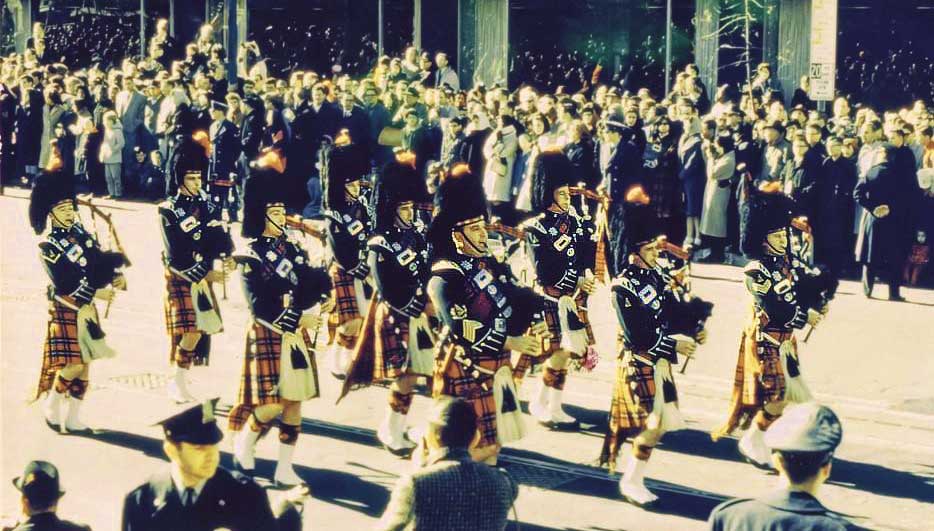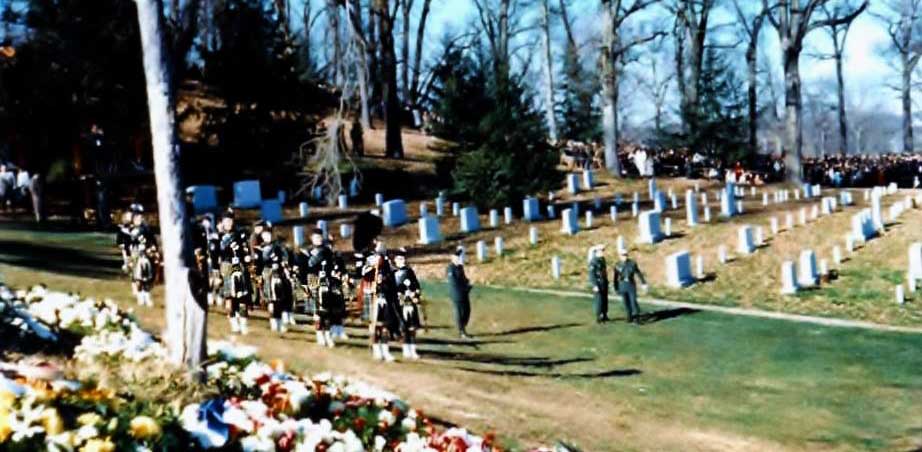The last happy days – the great highland bagpipe in JFK’s Camelot
By Major Robert Keith Gunther

This unprecedented participation of a foreign unit – The Black Watch – in the funeral for a President of the United States was the result of another of Mrs. Kennedy’s requests. The regiment received a letter from Mrs. Kennedy asking the band to perform four tunes at the funeral procession. Bruce Cowie said: “It is a hard thing to explain how I felt at the time. It was only later, afterwards, that there’s a realisation of what happened. You just realise you were part of history. The Kennedys as a family seemed to have a nice touch.”
The Black Watch Pipe contingent was in the third order of march behind a company of U.S. Marines. They were the 24th element out of 32 that made up the funeral procession. The Black Watch entered the funeral procession near the northwest gate of the White House when the funeral procession stopped at the White House momentarily. The Black Watch pipers left the funeral procession immediately after the service at St. Matthew’s Cathedral. Red Hackle magazine mentioned that, “It was bitter cold in Washington that day, with a wintry wind sweeping the wide avenues. The party had to wait two hours outside the White House for the procession to arrive (from the Capital building), by which time fingers were fast becoming numb and frozen”.
At 11:40am the cortege left the White House for the cathedral. During the procession, the Black Watch contingent didn’t play the normal repertoire associated with British military funerals but instead played tunes featured during the South Lawn Performance that were specifically requested by the State Funeral planners. They played Brown Haired Maiden, The Badge of Scotland, The 51st Highland Division and The Barren Rocks of Aden. Other tunes reported to have been played included The Green Hills of Tyrol, When the Battle’s Over, and The Old Rustic Bridge.
Private First Class (PFC) Arthur A. Carlson commented on the funeral procession from the White House to the cathedral: “I had trouble getting the beat, but once I learned to march with the music it gave me a burst of energy. That is music to fight by.” PFC Carlson went on to add that the march from the cathedral to the cemetery was the longest march segment of the state funeral. Estimated at three to four miles long, mourners lined the route from the cathedral to the gates of Arlington National Cemetery. “I remember I thought I had seen it all with the thousands of mourners at the Capitol. However, that was nothing compared to this. It was also an eerie sensation that except for a few shouts of encouragement from the crowd, there was absolutely no noise except for the deafening sound of drums. I was haunted by the sound of drums for days after the funeral.”

Bruce Cowie was from Kirriemuir in Angus and he was aged 24 in 1963. In 2013, he travelled to London to play alongside opera singer Alfie Boe to mark the 50th anniversary of the assassination. Bruce died in September 2017, just short of his 78th birthday. He had been the last surviving Black Watch piper to play at the funeral. He recalled in 2013, that the tune choice did not reflect the music the band would normally play at a funeral, and that the Black Watch pipers struggled to keep time with their US counterparts. As far as we were concerned, it was a bit of a debacle,” he recalled. “We were flown from Kentucky and went to an American airbase. We spent two-and-a-half hours doing the funeral marches, Flowers of the Forest, Land of the Leal, and all that stuff. Then our Pipe Major came in and he was livid – to say he was unhappy was to put it mildly. The bonnet went flying in the corner and he said, ‘you can forget it’. They don’t slow march, they do what you call trail arms – which means they are faster than we were.”
Cowie went on to add that, “nobody was happy with the tunes we had to play because they weren’t what we would say was in keeping with a funeral. They weren’t even slow marches. On reflection, if the Pipe Major had been given more time he could have come up with better tunes, but they were picked by the Americans. We weren’t happy about it, but the Americans seemed to enjoy what we played”.
Immediately following the state funeral on November 25, 1963, the nine Black Watch pipers flew to Lexington, Kentucky and rejoined the rest of the regiment’s tour, which had a performance that night. The OC Tour spoke with the local sponsors for an hour and a half as well as the British embassy in Washington on whether to perform that night as it was a national day of mourning. A large audience assembled for that night’s show and a second tribute to JFK “went down excellently” according to Red Hackle magazine. It also stated that “the funeral party got back in a General’s plane right before the show”. What a day for those nine pipers!
Keeping with her impeccable etiquette, Mrs. Kennedy sent a thank you letter to Major Wingate-Gray on December 16, 1963. She stated about the pipers that, “their presence was a great tribute to the President and contributed a great deal to the ceremony”. She also thanked him for sending two Black Watch toy soldiers to the Kennedy children as birthday presents (John Jnr’s birthday occurred on the day of the state funeral and Caroline’s birthday occurred two days afterwards.). The thank-you letter is distinctly different in that the White House logo is replaced by the words, “Mrs. John F. Kennedy”. (Incidentally, Michael Wingate-Gray died in November 1995. He had gone on to become a Brigadier General and Commanding Officer of the SAS.)

The USAF Pipe Band
The USAF Pipe Band was founded in 1950 by Colonel George S. Howard and comprised exclusively of players of Scottish and Irish ancestry. Theband was in New Orleans when JFK was assassinated. The band had arrived the day before and the men were relaxing in barracks, preparing for an evening show when they were notified. Piper Jerry Cashion of the band recalled years later: “We were in a gymnasium, ready to play … and we were getting dressed, ready to go. And the announcement came over the loudspeaker that Kennedy had been shot. “Immediately, they packed us up and brought us back to Washington, D.C. We had to stay on base all weekend, and learn this new tune they told us we had to play [Mist Covered Mountains]. The band learned it quickly and practiced the ceremonial march ahead of the funeral on November 25 during that cold Monday in Washington, D.C.”
November 25 turned out to be a bright, sunny, but very cold day. The pipe band reported to Arlington in the early morning for a run-through of the graveside ceremonies to take place later that day. “We rehearsed in our full outfits,” recalled the band’s SSgt John G. Bosworth, “and it was cold as hell.” After their dry run, the band moved to an area near the Old Amphitheater to run through the music and marching one more time to ensure perfection.
The band then staged “on the hill in front of the Custis-Lee Mansion [now called the Robert E. Lee Memorial – Editor]. It was a perfect view to watch the magnificent, solemn pageantry of a state funeral unfold. Bosworth related that they were waiting in position for about an hour and a half and could see each marching unit in the state funeral as it approached the gates to Arlington. Upon arrival at Arlington National Cemetery, the marine band opened the graveside rites with ruffles and flourishes and played the national anthem. When the anthem ended, the Air Force pipers began.
As the coffin was moved from the caisson to the burial site, the Air Force pipers played ” Mist Covered Mountains. The band slowly marched by the grave and onto the street. They were led by Drum Major Seamus (Jim) Neary. Overhead, 50 jet fighters flew in formation, followed by Air Force One. After the funeral, the band returned to Bolling Air Force Base. The USAF Pipe Band performance (and the 50 jets flying overhead) can be watched at 32:27 into this 34 minute-long clip: http://www.youtube.com/watch?v=3KJQkn6zUvM.
The USAF Pipe Band members who played were: Drum Major SSgt James Neary, SSgt N. B. Sandy Jones, A1C Tom Kirkpatrick, TSgt Melvin (‘Mel’) Ross, SrA Jack McGilvary, TSgt George Lucas, A1C Jerry Cashion, SrA Robert Fulton, SrA Richard (“Dick”) Rau, SSgt John Ryan, SSgt LeRoy Carroll (bass drum), SrA Ward Willis and SSgt John G. Bosworth.
Norval ‘Sandy’ Jones began piping at the age of eight under George Mars of Victoria, British Columbia, Canada. He served as the Pipe Major for the U.S. Air Force Pipe Band for eight years. As a member of the pipe band he often performed for Presidents, heads of state, and dignitaries of foreign nations. During his tenure in the Air Force he continued his studies of the bagpipe with Jack Chisolm of Inverness, Scotland and the late John MacFadyen. In 1970, he and John MacFadyen co-founded the North American Academy of Piping. Sandy is the author of the tutor ‘Beginning the Bagpipe’. He travels throughout North America judging at highland games, conducting workshops, and performing at recitals. He retired from The Citadel in Charleston, SC where he taught bagpipes for 25 years. Sandy was awarded the Balvenie Medal in 2017.
Although collective memory of the JFK presidency culminates with the sound of the great highland bagpipe carrying this energetic young American President to his early grave, our instrument’s drones and tunes were heard on the brightest days of his presidency. Pipers were present at the first and last official state events and at numerous other events in between. The most celebrated moment was that of the Black Watch performance on the South Lawn, but they were not the only pipers present during Camelot. The great highland bagpipe’s presence during the state funeral reflected its high regard by the Kennedy family, not to mention the unprecedented honour of inclusion of a foreign military unit.
The collective memory of only one pipe band at the state funeral is incorrect. There were actually two distinct units: The Black Watch and the USAF Pipe Band. Appreciation for the Black Watch presence at the funeral is still resident in American collective memory, as observed by Major Steven Small, former Director of the Army School of Bagpipe Music and Highland Drumming: “I was proud to serve with the Black watch on subsequent tours in USA,” he said “and this event [JFK’s funeral] was never far from conversation with all US citizens that we met.”
• Pipe Major Willie Gilmour was the senior Pipe Major of the Canadian Armed Forces for many years. He composed this hornpipe in 1965. It appears in Captain John A. MacLellan, M.B.E.’s More Music For The Highland Bagpipe and A Collection of Pipe Music of the Black Watch (Royal Highland Regiment):






